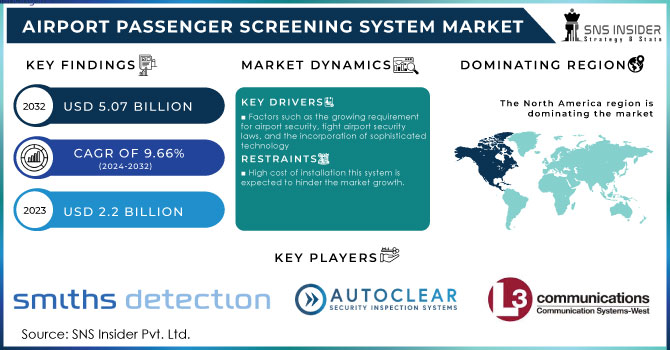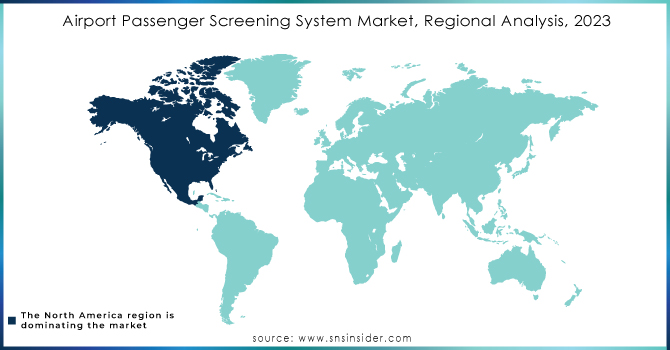Airport Passenger Screening System Market Report Scope & Overview:

To get more information on Airport Passenger Screening System Market - Request Free Sample Report
The Airport Passenger Screening System Market Size was valued at USD 2.2 billion in 2023 and is expected to reach USD 5.07 billion by 2032 with a growing CAGR of 9.66% over the forecast period 2024-2032.
A passenger screening system at an airport is one that scans passengers before they board a flight.The screening devices are intended to protect civil aviation against accidental harm, terrorist attacks, and other hazards. It checks individuals, their possessions, and cargo for forbidden goods like as metal objects, firearms, and booze. The increased frequency of security risks on civil aircraft, such as hijacking, robbery, and bombing, increases demand for full-body scanners and more advanced passenger screening technology.
Europe's aviation industry is rapidly increasing. The region's increased passenger traffic prompted the construction of new terminals and the enlargement of existing terminals to accommodate more passengers, particularly at medium and small airports. The aforementioned aspect is propelling the region's airport passenger screening systems market forward. Because of the region's increased terrorism and illicit drug traffic, the region's customs department and airports have adopted enhanced passenger screening technologies to detect threats.
MARKET DYNAMICS
KEY DRIVERS
-
Factors such as the growing requirement for airport security, tight airport security laws, and the incorporation of sophisticated technology
-
Because of economic growth, the number of air traveller is increasing.
RESTRAINTS
-
High cost of installation this system is expected to hinder the market growth.
-
Concerns among airport regulatory authorities, including as fear of invasion of privacy, as well as concerns about the negative health impacts of full body scanning among flight traveller, may stymie the implementation of screening devices.
OPPORTUNITY
-
People screening technology is providing answers to security questions and expanding the list of prohibited commodities that can be discovered automatically.
-
Collaborations and partnerships among supply chain enterprises will provide a profitable business opportunity.
CHALLENGES
-
The increasing number of terrorist and unfriendly actions around the world is forcing countries to strengthen their customs and border security.
IMPACT OF COVID-19
National and international transportation have been hampered as a result of the lockdown applied in many nations, which has greatly impacted the supply chain of airport passenger screening systems around the world, consequently expanding the supply-demand imbalance. As a result, insufficient raw material supply is likely to slow the manufacturing rate of these systems, thereby impacting market growth. Furthermore, as a result of the COVID-19 pandemic, manufacturing processes for airport passenger screening equipment have dramatically decreased. This is mostly due to the production shutdown and disrupted supply chain, which has impacted the market's global operations and revenue.However, as governments around the world begin to relax laws for resuming company operations, the situation is projected to improve.
A passenger screening system at an airport is one that scans passengers before they board a flight. Even after passing through the screening apparatus, traveller are typically inspected manually by police personnel using a metal detector. However, due to the ongoing increase in global aviation traffic, the demand for secure and effective screening systems has increased dramatically in recent years. Improving present screening methods is critical because passengers continue to be an important component of airport operations, and efficiency in the same can help boost the airport's timely performance and operability. Commuter screening methods at airports have recently received increased attention from both the government and business organizations.
The number of air travel passengers is increasing as economies expand, which significantly contributes to market growth. Furthermore, an increase in disposable income, low-cost airfares, and efficient airline services increase the need to protect passenger safety in crucial situations, which is expected to be one of the major reasons driving the growth of the airport passenger screening system market.
Stringent airport security laws are likely to give attractive growth prospects in the airport passenger screening systems market due to an increase in the prevalence of security threats and smuggling of prohibited commodities around the world. Furthermore, the integration of modern technology enabling screening equipment to promote public safety and boost airport operating efficiencies is likely to fuel market expansion.
KEY MARKET SEGMENTATION
By Airport Type
-
International Airport
-
Domestic Airport
By Type
-
Metal Detectors
-
Magneto Static Detectors
-
Explosive Trace Detectors
-
Advanced Imaging Technologies
REGIONAL ANALYSIS
The market for airport management systems is divided into four key regions: North America, Europe, Asia Pacific, and the Rest of the World. North America is currently expected to lead the market throughout the projected period, owing to the presence of prominent companies such as American Science and Engineering, Inc., Analogic Corporation., and C.E.I.A. SpA.
Asia-Pacific is predicted to be the fastest-growing region during the projection period. This increase is linked to China's and India's growing populations, which are driving up air traffic in both countries.
The continuous expansion of international airports, as well as significant expenditures by private key players, are expected to drive significant growth in the airport passenger screening industry.
Due to a large number of domestic and international airports and accompanying infrastructure in the United Kingdom, France, and Germany, Europe experiences significant expansion during the forecast period. In the rest of the world, new airport developments in Latin America, the Middle East, and Africa are driving the market.

Need any customization research on Airport Passenger Screening System Market - Enquiry Now
REGIONAL COVERAGE:
-
North America
-
USA
-
Canada
-
Mexico
-
-
Europe
-
Germany
-
UK
-
France
-
Italy
-
Spain
-
The Netherlands
-
Rest of Europe
-
-
Asia-Pacific
-
Japan
-
south Korea
-
China
-
India
-
Australia
-
Rest of Asia-Pacific
-
-
The Middle East & Africa
-
Israel
-
UAE
-
South Africa
-
Rest of Middle East & Africa
-
-
Latin America
-
Brazil
-
Argentina
-
Rest of Latin America
-
KEY PLAYERS
Thje Major Players are Smiths Detection, American Science and Engineering, Analogic, AUTOCLEAR, L-3 Communications Security & Detection Systems, CEIA, RapiScan Systems, Nuctech, Optosecurity, Kromek Group Plc. and Other Players
| Report Attributes | Details |
|---|---|
| Market Size in 2023 | US$ 2.21 Billion |
| Market Size by 2032 | US$ 5.07 Billion |
| CAGR | CAGR of 9.66% From 2024 to 2032 |
| Base Year | 2023 |
| Forecast Period | 2024-2032 |
| Historical Data | 2020-2022 |
| Report Scope & Coverage | Market Size, Segments Analysis, Competitive Landscape, Regional Analysis, DROC & SWOT Analysis, Forecast Outlook |
| Key Segments | • By Airport Type (International Airport and Domestic Airport) • By Type (Metal Detectors, Magneto Static Detectors, Explosive Trace Detectors, Advanced Imaging Technologies, and Full Body Scanners) |
| Regional Analysis/Coverage | North America (USA, Canada, Mexico), Europe (Germany, UK, France, Italy, Spain, Netherlands, Rest of Europe), Asia-Pacific (Japan, South Korea, China, India, Australia, Rest of Asia-Pacific), The Middle East & Africa (Israel, UAE, South Africa, Rest of Middle East & Africa), Latin America (Brazil, Argentina, Rest of Latin America) |
| Company Profiles | Smiths Detection, American Science and Engineering, Analogic, AUTOCLEAR, L-3 Communications Security & Detection Systems, CEIA, RapiScan Systems, Nuctech, Optosecurity, Kromek Group Plc. |
| DRIVERS | • Factors such as the growing requirement for airport security, tight airport security laws, and the incorporation of sophisticated technology • Because of economic growth, the number of air traveller is increasing. |
| RESTRAINTS | • High cost of installation this system is expected to hinder the market growth. • Concerns among airport regulatory authorities, including as fear of invasion of privacy, as well as concerns about the negative health impacts of full body scanning among flight traveller, may stymie the implementation of screening devices. |

